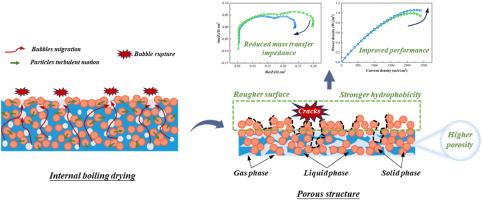质子交换膜燃料电池内沸腾干燥方式提高催化剂层孔隙形成和传质能力
IF 7.9
2区 工程技术
Q1 CHEMISTRY, PHYSICAL
引用次数: 0
摘要
干燥过程是决定质子交换膜燃料电池(pemfc)催化剂层微观结构和输运性能的关键步骤。干燥方式是影响催化剂层结构的重要干燥因素,目前对其了解甚少。本研究提出利用气液平衡相图控制CL的干燥方式,并研究了干燥方式对CL结构形成和传质能力的影响。结果表明,内沸腾干燥作为一种有益的干燥方式,具有更高的孔隙率、更强的疏水性和有利的裂缝,提高了CL传质能力。此外,还揭示了CL内沸腾干燥过程的机理。在内沸腾干燥模式下,气泡产生的扰动效应促进了二次孔的形成。由于干燥速度快,加之顶部汽泡破裂,导致表面粗糙且有裂纹。在单电池测试中,传质阻抗的降低和性能的提高表明,与传统的表面蒸发干燥相比,内部沸腾干燥模式是CL制造更理想的选择。研究结果为CL干燥过程的设计和控制提供了重要的见解。本文章由计算机程序翻译,如有差异,请以英文原文为准。

Boosting pore formation and mass transfer capacity of catalyst layer by internal boiling drying mode for proton exchange membrane fuel cells
The drying process is the critical step to determine the resulting microstructure and transport properties of catalyst layer (CL) in proton exchange membrane fuel cells (PEMFCs). Drying mode is an essential drying factor affecting the catalyst layer structure, which is poorly understood at present. This study proposes using the gas-liquid equilibrium phase diagram to control the CL drying mode, and investigates the impact of drying mode on CL structure formation and mass transfer capacity. Results indicate that internal boiling drying as a gainful drying mode boosts the CL mass transfer capacity with higher porosity, stronger hydrophobicity, and beneficial cracks. Moreover, the mechanism of internal boiling drying process in the CL is revealed. The disturbing effect created by the vibrant vapor bubbles promotes the formation of the secondary pores under internal boiling drying mode. The high drying rate combined with vapor bubble rupturing at the top cause the rough surface with cracks. The reduced mass transfer impedance and improved performance in single-cell tests suggest that the internal boiling drying mode is a more desirable option for the CL fabrication compared to conventional surface evaporation drying. The findings provide crucial insights for the design and control of CL drying process.
求助全文
通过发布文献求助,成功后即可免费获取论文全文。
去求助
来源期刊

Journal of Power Sources
工程技术-电化学
CiteScore
16.40
自引率
6.50%
发文量
1249
审稿时长
36 days
期刊介绍:
The Journal of Power Sources is a publication catering to researchers and technologists interested in various aspects of the science, technology, and applications of electrochemical power sources. It covers original research and reviews on primary and secondary batteries, fuel cells, supercapacitors, and photo-electrochemical cells.
Topics considered include the research, development and applications of nanomaterials and novel componentry for these devices. Examples of applications of these electrochemical power sources include:
• Portable electronics
• Electric and Hybrid Electric Vehicles
• Uninterruptible Power Supply (UPS) systems
• Storage of renewable energy
• Satellites and deep space probes
• Boats and ships, drones and aircrafts
• Wearable energy storage systems
 求助内容:
求助内容: 应助结果提醒方式:
应助结果提醒方式:


